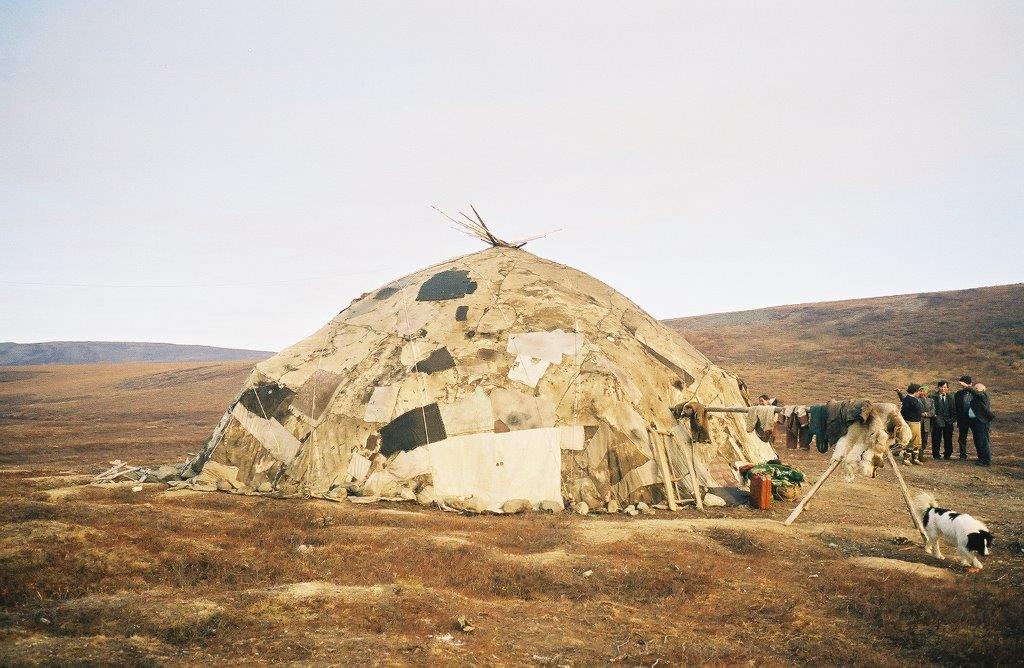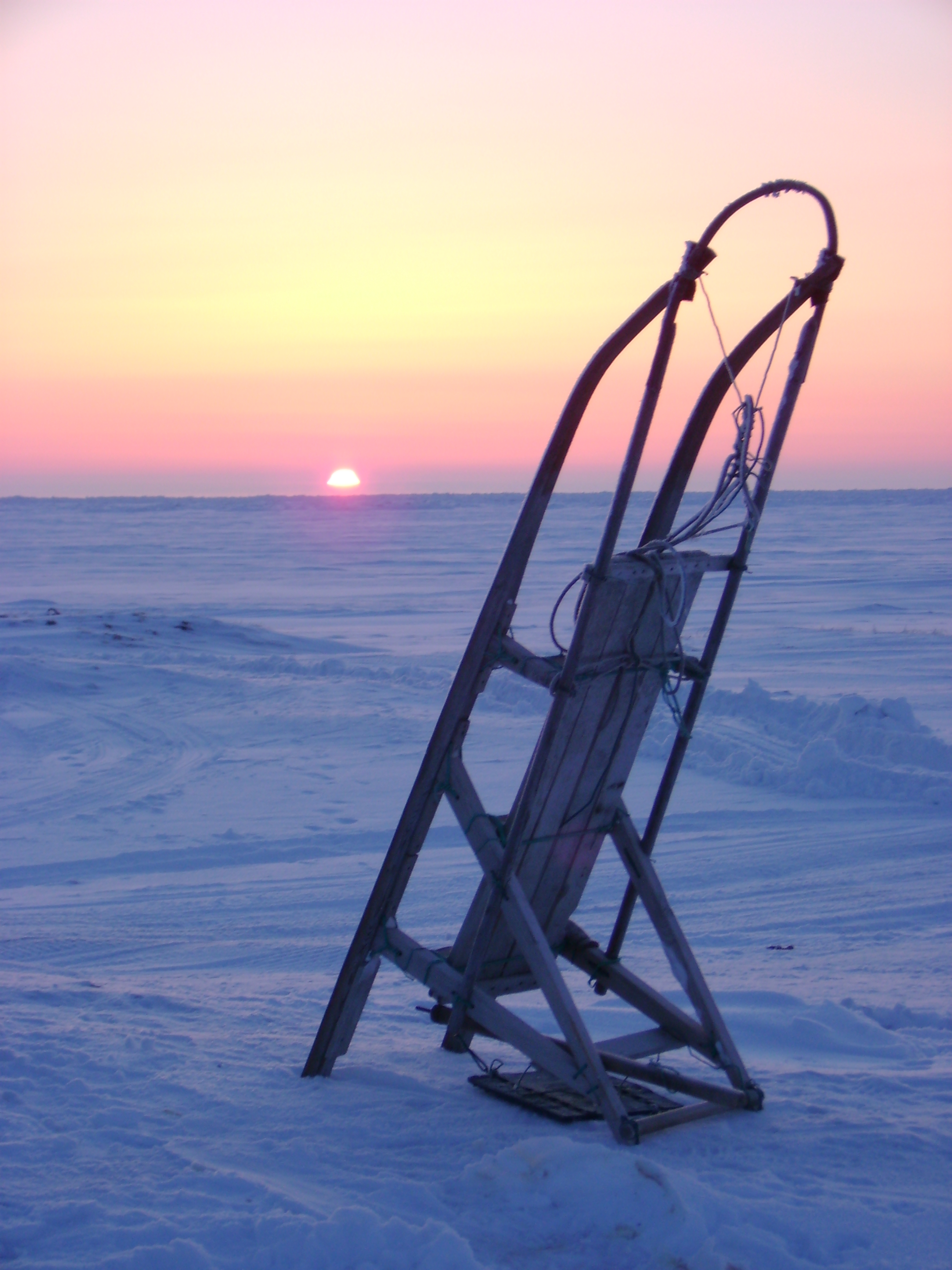This month’s selection contains both dreamy visions and the harsh realities of the Arctic’s landscape and recent human history. While these novels feature racism, chauvinism and the products of Soviet despotism, one is also reminded of the beauty and vastness of Russia’s lands, and the resilience and innovation of her people.

A Chukchi yaranga, or reindeer skin home. (Photo Courtesy Margaret Williams)
A Dream in Polar Fog
As I read “A Dream in Polar Fog” by Yuri Rytkheu, I recalled my visits to the Russian Arctic, traveling to coastal villages with Chukchi colleagues involved in polar bear and walrus conservation. Immersed in Rytkheu’s words, I again heard the crunch of boots on dry snow, and sled dogs howling in excitement before a trip on the ice. I felt the sharp winds of a storm buffeting the walls of a yaranga, the sturdy reindeer-skin homes. (My Chukchi friends live in contemporary Western-style homes, but their inland cousins continue to use yarangas as the most practical housing for their mobile lifestyle.)
“A Dream in Polar Fog” begins in 1910, when Canadian sailor John MacLennan suffers severe injuries detonating explosives to free a path for his ice-locked ship. The captain of the Belinda must turn to the village of Enmyn for help. Wary of white Westerners, known for bringing disease and misfortune to Indigenous communities, the Chukchi village elder Orvo confers with others. After much deliberation, Orvo, Armol and Toko agree to take MacLennan overland by dog sled to the nearest doctor – at least three days away. Fever and hallucination set in, along with gangrene in the injured man’s hands. John is terrified, convinced that the unfamiliar people he considers strange “savages” are going to kill him.
One week later, however, he has been returned safely to the village, having had most of his fingers amputated by a medicine woman with the precision of a top-notch surgeon. Learning that the Belinda has sailed without him, John is at first despondent, but then rallies, gradually fending for himself and others. What begins as revulsion toward the Chukchi people evolves into interest, then deep respect for their way of life on the edge of the continent.
Sometimes Rytkheu, of Chukchi heritage himself, is our narrator, while at other times the story is told from Orvo’s or MacLennan’s point of view. Throughout the novel, Rytkheu paints for his readers the hues and shades of life in the Arctic. Describing nightfall on the tundra, he writes, “The air became more and more blue as though some one enormous and invisible were thickening the color. The snow that stretched ahead was blueing, the bumps, the hillocks and the snowdrifts were blueing, and the sky too, lighting up the stars; and the blue seeped into the sleds’ tracks, into the dogs, the harnesses, and Toko’s face, framed by wolverine fur.”
Readers of this book are treated to history, lessons in Chukchi traditional knowledge, a bit of romance, adventure and pure, beautiful writing.

The author is seen with Charlie Johnson, a since-deceased Alaska Native leader and advocate for joint U.S.-Russia management of shared polar bear populations. (Photo Courtesy Vladilen Kavry)
One Day in the Life of Ivan Denisovich
In June 1993, I made my first trip to Russia, stopping in Moscow on my way to work with a biologist in the far eastern region of Magadan. My hostess was horrified. “Magadan! Why on earth do you want to go there?” she asked. As the center of the infamous Soviet Siberian labor camp, or gulag, system, Magadan still evokes painful memories of the worst of Soviet history. Millions of political prisoners were sent to toil and often die from torture, violence and severe Siberian conditions. That summer, while exploring Magadan’s salmon-filled rivers, coniferous forests and coastal islands – landscapes bursting with wildlife – occasionally I found signs of old camps, and thought of the many who perished there.
“One Day in the Life of Ivan Denisovich” was a watershed in revealing life in the gulag. Author Aleksandr Solzhenitsyn received a Nobel Prize for his work in 1970 and was expelled from the Soviet Union in 1974. The gulag system was reduced after Stalin’s death in 1953, though numerous camps for political prisoners continued to operate. Solzhenitsyn’s novel is a must-read for students of Russia, to remember this chilly part of the nation’s history.
Solzhenitsyn’s novel portrays the deprivation, suffering and psychological horrors of living in limbo under a brutal regime. Ivan Denisovich learns the tricks of survival and something approaching pleasure, by savoring a cigarette here, sleeping an extra minute there. In camp, he tells us, “you had to eat with all your mind on the food – like now, nibbling the bread bit by bit, working the crumbs up into a paste with your tongue and sucking it into your cheeks. And how good it tasted, that soggy black bread!” Power struggles and hierarchy are constant concerns in the camp, as is having the right connections: “A clever team leader was one who concentrated on the work report. That was what kept the men fed … And you? You got an extra two hundred grammes of bread for your supper. A couple of hundred grammes ruled your life.”
Though terror rules the camp, each day after sunrise, Ivan Denisovich finds moments of freedom. “While the authorities were sorting things out you stuck to the warmest place you could find. Sit down, take a rest, you’ll have time enough to sweat blood. Good if you can get near a stove. Unwrap your foot-cloths and warm them a little. Then your feet will keep warm all day. And even without a stove it’s good to sit down.”

A spring sunset is seen behind a sled. (Photo Courtesy Craig Perham)
Once Upon the River Love
Over two decades ago, when I stood on the banks of the Amur River, which forms the border between Russia and China, just a tiny trickle of people were crossing the river. Today, however, the Amur – one of the longest rivers in the world – is a major vector for commerce and transportation. This giant ribbon of water weaves through a vast watershed, home to diverse cultures, aquatic biodiversity and wilderness. Amur (Siberian) tigers and Amur leopards roam semi-temperate, semi-tropical forests that meet the sea where the Amur empties into the ocean.
For this reason, I was intrigued to read Andrei Makine’s novel, “Once Upon the River Love,” a sensual reminiscence of a boy’s coming of age in the Amur region. Our narrator Dmitry and his friends – Utkin and Samurai – comprise a small and loyal gang, exploring the natural world and their own nature as young men.
Makine’s over-saturated descriptions of the snow and sky, and his misty sentences that trail off, mimic the voice of a daydreamer. As Dmitry walks through the forest, he observes how “the castellated ramparts of the taiga retained their look of happy abandonment and soft idleness. The curtain of snowy plumes enchanted the eye with its silent eddying … I had an intense feeling for its beauty and its aroused expectations!”
Although Makine grew up in Russia (then moved to France), his characters seem to be disconnected from the real essence of the forest and rivers, describing them as one imagines they should be in a painting. Or maybe that is the point: In the process of exploring who they are, young people are still searching for the truth in their surroundings.
I plowed through the short book, but got stuck at passages like this: “In every movement of the air, woman was present. Nature was a woman! In the intoxicating giddiness of the great flakes as they caressed my face. In the long languid calls of the jackdaws as they greeted the mild weather. In the heightened tawny color of the pine trunks beneath the damp luster of the melted hoarfrost.” After a series of these dreamy reflections, I was ready for some action. I wanted the characters to actually do something. Had I been a more patient reader, I might have enjoyed the unfolding action of a writer exploring the themes of love and friendship.
This commentary is part of an ongoing series about literature from around the Arctic. Read about the rugged lands and independent people of Iceland and Denmark’s kingdom of island and oceans.
The views expressed in this article belong to the author and do not necessarily reflect the editorial policy of Arctic Deeply.
Never miss an update. Sign up here for our Arctic Deeply newsletter to receive weekly updates, special reports and featured insights on one of the most critical issues of our time.
